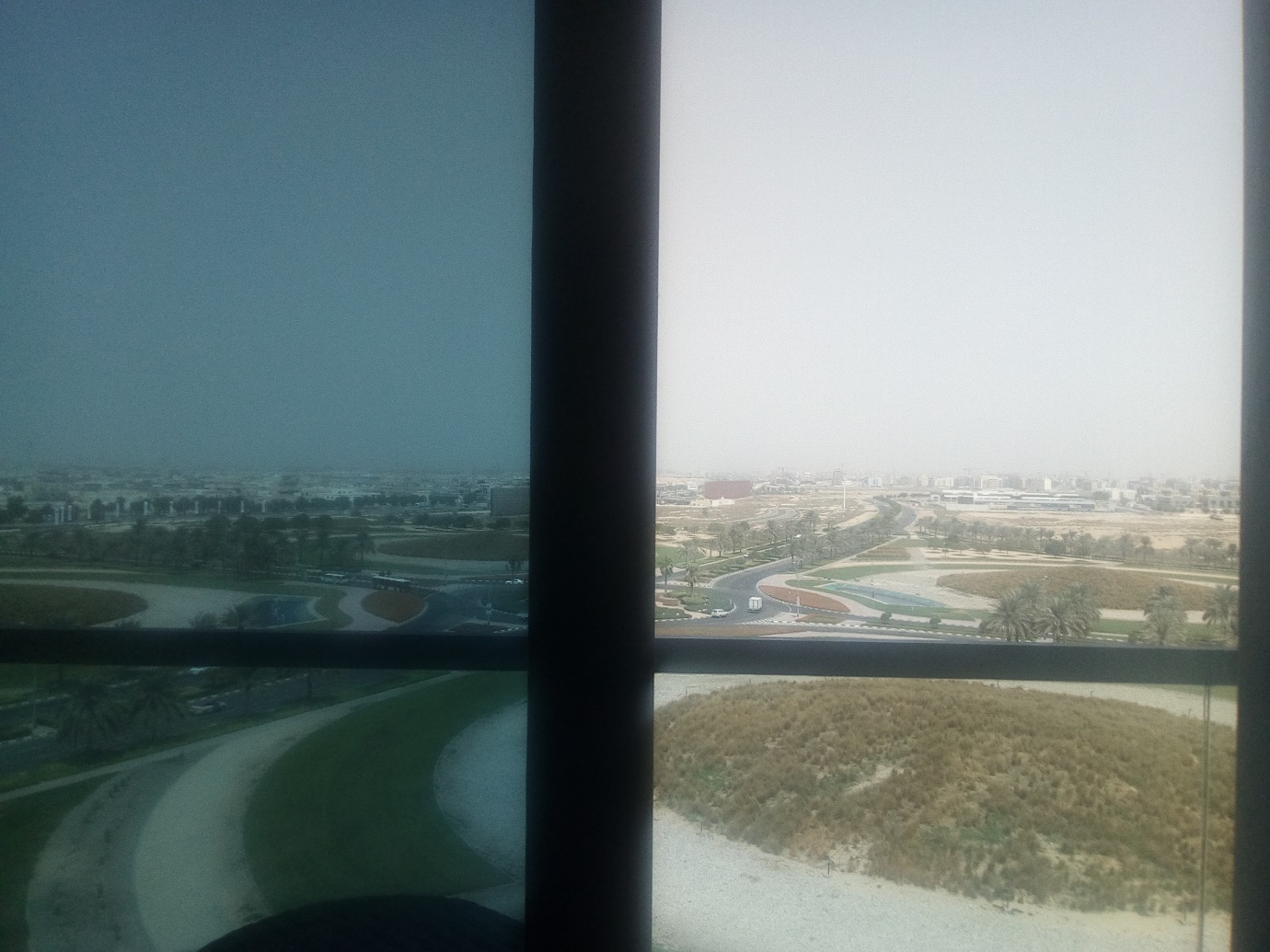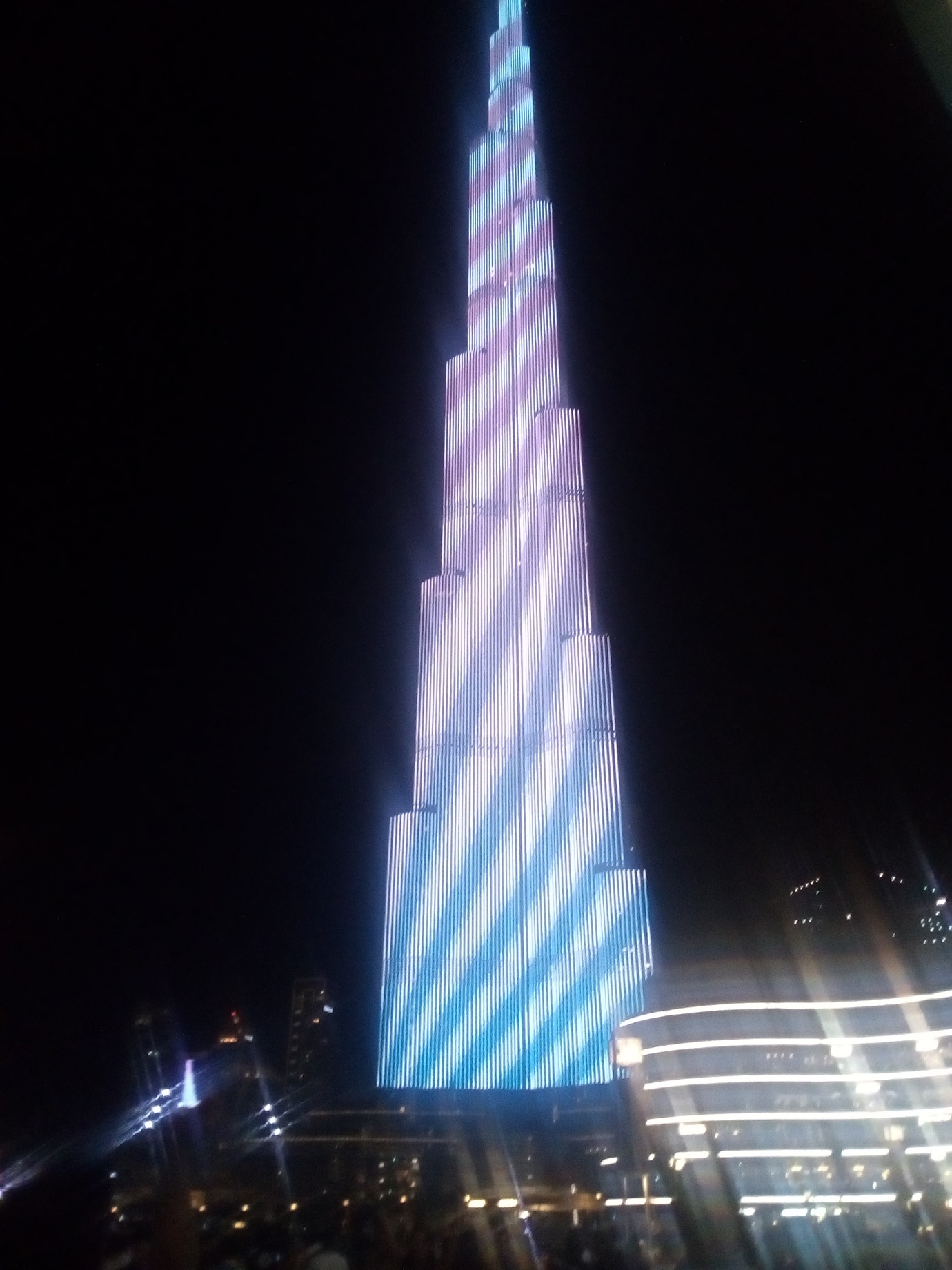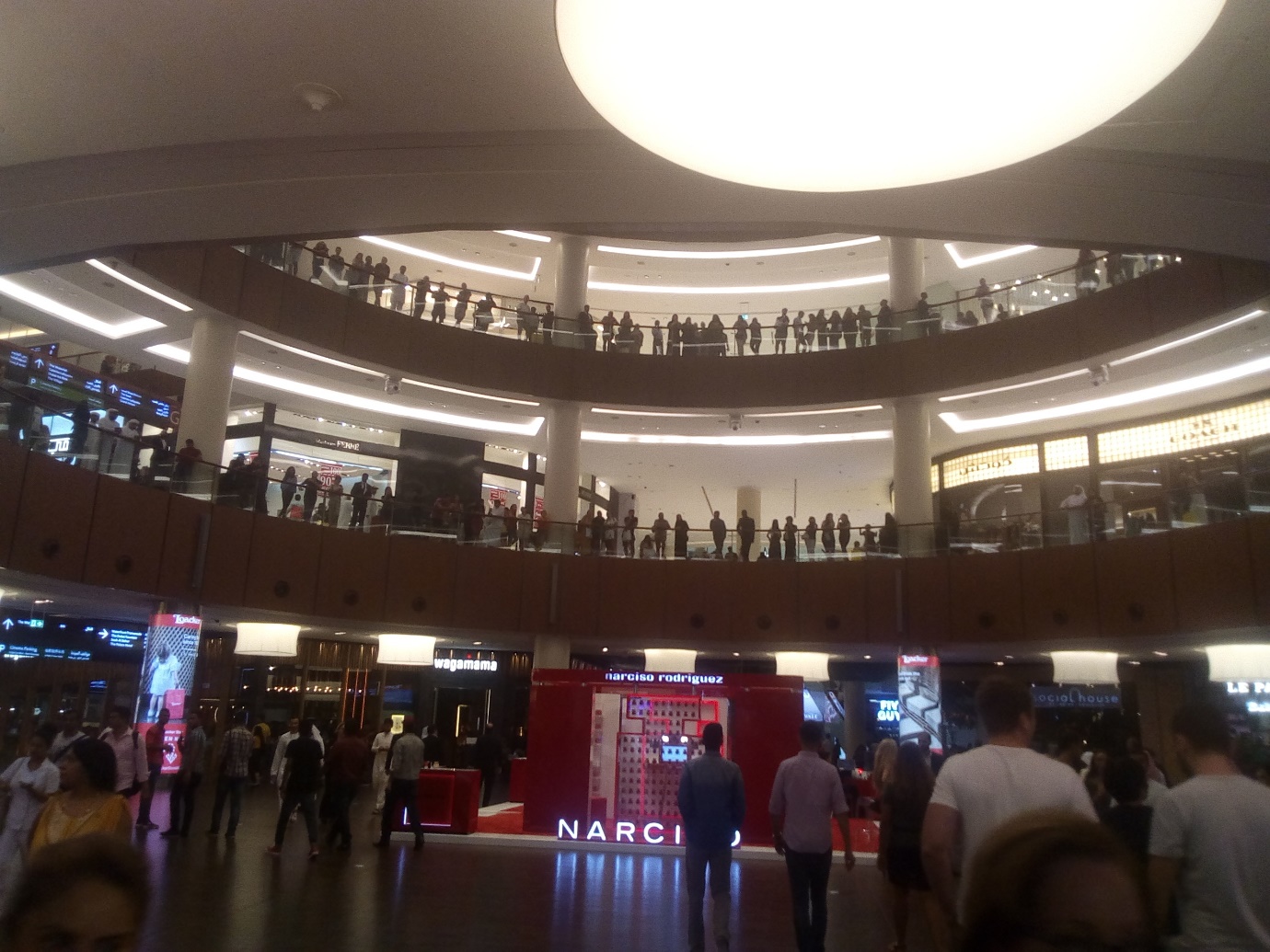Professor John Bryson reflects on his time visiting the new campus of the University of Birmingham Dubai.
It is a rather chilly 8am on Sunday 30 September 2018. By chilly, I mean that it is only 31°C here but by 1pm it will be 37°C. Back in the former workshop of the world, the West Midlands, it is predicted to reach 13°C today. I am living in Dubai for 10 days to visit the new campus of the University of Birmingham Dubai.
Dubai is an interesting place, a place of contrasts. I have an apartment and from this table I can see, in the distance, a busy highway with streams of cars and lorries and the occasional pale-yellow school bus.
 Photograph 1: Apartment View, Dubai
Photograph 1: Apartment View, Dubai
It is a strange view; I see this through tinted glass. From here it seems to be muted but viewing the city-region from the balcony is a very different experience – the city changes colour, it is a city transformed.
Photograph 2: Shades of Beige – Seeing a City-Region through Tinted Glass
We must remember that we always see a city through some form of tinted lens – we see what we want to see. We see very little; a limited field of vision and the limitations are imposed by our experiences, interests and backgrounds.
The distinctiveness of a city is partly about colour and also about smell – it is a complete immersive sensual experience. This is a city of many shades of beige, a pale sandy fawn. Last weekend, I was in Gothenburg, Sweden – a red-roofed city. The contrast between Gothenburg and Dubai is extreme – colours, sounds, smells, temperature. I can count over 20 cranes that are visible in the distant haze. Overhead, an A380 is passing. Part of this view includes a residential suburb and, in the distance, emerging from the haze is the Burj Khalifa, the tallest building in the world (163 floors, 828m).
Photograph 3: Burj Khalifa, Dubai
The other part of the view includes desert. I am staying in a zone designated as an industrial area, Silicon Oasis, and this is close to a zone designated as Academic City. The University of Birmingham Dubai is based at Academic City. In the distance, there is another city zone – Dubai Festival City. This is a business, conference and entertainment area developed around a large shopping mall that includes everything that one would expect from a mall – international fashion, designer furniture, a cinema complex, global food courts and entertainment places.
Dubai makes me think of many things. I want to write about two of these. First, I have a book in press that will be published in December under the title “A Research Agenda for Regeneration Economies: Reading City-Regions”. The subtitle is especially important and raises the interesting question of “how to read a city-region?”, or “how to read a place like Dubai?”. On the first page of this book we note that “At the centre of the analysis of city-regions is heterogeneity and a complex interplay between place, space and a concatenation of spatial and sometimes aspatial processes”. A city-region also has its own special or distinctive ‘essence’ and the use of this term highlights that many aspects of a city-region cannot be measured but perhaps can only be experienced. Reading a city-region is partly an exercise is trying to capture an appreciation of the essence of a place.
There is another way of considering a city-region. This is to argue that urbanization is a process that includes on-going transformations in the intensity of a place. Central to this process is the speeding up of the interconnections that exist within a place – flows of people, goods, information – combined with an ever spatially-spreading web of connections to other places. Dubai is very much a place of connections – from a place that attracts leisure, business and educational tourists to the role played by Dubai International Airport as a transfer hub. Reading Dubai is an exercise in identifying and understanding a complex interconnected web of local and international flows but set within the context of appreciating the essence of this place and its ever-changing intensity. Central to these flows, for Dubai, are flows of people. There are many such flows. Some are very temporary – from airport transfers to short holidays – and some involve much longer but still temporary visits. People pass through this place with varying degrees of intensity. This morning, in the elevator, I was surprised to meet a mother with her two children. They were visitors to this place, but these children were on their way to school. It is worth remembering that for Dubai the weekend is defined as Friday and Saturday and the working week commences on a Sunday. This is a city-region with a very different rhythm to Birmingham.
Second, names have many meanings – as simple identifiers but also as signs with signifiers and signifieds. A signifier is the physical form of a sign (the word, a building, an object, an artefact, a person) while a signified is the meaning or idea expressed by a sign (Rusten et al., 2007). Applying a name that has developed a complex signified over centuries to another activity, function or organisation is an exercise in trying to transfer a signified from one organization to another. This might be accidental or be planned. It is a complex process, as it tries to link one reputation with another on the assumption that readers of this sign will appreciate the association and their decision-making will be influenced. It fails when readers do not make or understand the association or see through the exercise in sign transfer.
Place-making, city-region making, is an exercise in the creation and projection of a place-based sign, a brand or identity. Thus, the essence and intensity of Dubai is connected to the shaping of the Dubai city-region’s sign or brand. This is a very complex process that includes many interconnected layers of meaning and also involves transferring signifieds – from place-to-place; from company-to-place from celebrity-to-place. It is also a brand that is read, interpreted and misinterpreted. This is the case for all ‘signs’; a process of translation and distortion occurs between a sign and the reader(s). This means that reading a city-region is partly an exercise in reading the ways in which a place’s brand has been developed, created and evolved, but is also interpreted. It is also important to appreciate the diversity of readings and experiences as people from very many different backgrounds try to read a place. This can be a shallow reading as people rapidly pass through a place, while for some this is an exercise in reading and engaging with a place as an exercise in everyday living. This brings me back to the two children staying in a hotel apartment, but on their way to school. Their reading and experience of Dubai will be very different to mine.
Last night I visited Dubai Mall , the second largest shopping centre in the world, that is also adjacent to the tallest building and includes the Dubai Fountain, the world’s largest choreographed fountain system.
Photograph 4: Dubai Mall, 10pm
It also includes the Dubai Dino, a genuine Diplodocus fossil, that comes from the Dana Quarry, Wyoming, US (Photograph 5). Reading city-regions is also an exercise in understanding and reading theatre. The Dubai Mall is a carefully crafted theatrical experience. It also highlights the relationship between lifestyle and climate. Here, the mall is a place for walking, strolling, eating, entertainment – like all malls, but it is also an air-conditioned place. The climate provides Dubai with a very different rhythm to the city. Last night, after 10pm, the mall was open, the stores were open, and people were strolling. The Bull Ring, back in Birmingham, closed at 8pm. The temperature and the air-conditioned spaces provide a very different rhythm to this city.
Photograph 5: Dubai Dino
One part of my reading of Dubai, is based on an account of theatre and spectacle, and another about the construction of a place-based brand that includes spectacular infrastructural investments – tallest building, the Dubai Fountain and we must not forget Dino. It is also about transferring signifieds including those from established celebrities and well-known companies. Two days ago, “The Eagle Landed in Dubai”. I walked past her yesterday. The Eagle is “bad girl RiRi” or Rihanna. She was here to host a one-day beauty masterclass with tickets priced at AED 5,500 (£1,500) to 7,500 (£2,000). This was a class in the flawless application of cosmetics. She also partied at the Burj Khalifa and visited Sephora, Dubai Mall (a retail chain selling cosmetics, skin care, makeup, fragrance & perfume, hair, beauty products and makeup tips). RiRi’s visit perhaps highlights one aspect of the intensity and essence that is Dubai. One reading of Rihanna is as singer, songwriter, actor, diplomat, ]and businesswoman who is known for reinventing her style and image. Dubai is, if anything, an exercise in the reinvention of a place-based style and image – of a set of interconnected signs.
Yesterday evening, “the world rushed in” to view RiRi. This quotation comes from a very well-known book about the Californian gold rush (Holliday, 2002). One could argue that Dubai is a place that is experiencing a rushing in of the world. Dubai and RiRi have much in common. Both are brands and are an exercise in branding and brand management. Both involve developing and projecting a set of signs with signifiers and signifieds; both are about the projection of the flawless application of cosmetics and both require an ability to attract people. One element of a reading of Dubai, is of a created place, a crafted place, a service space, an entertainment place, an educational hub, a transfer place, but a place designed to attract visitors of many types.
There are many ways to read Dubai, but all readings must include an account of theatre, spectacle and the construction of a place-based identity, a brand and a collection of linked signs. All this, like RiRi, is an exercise in creating or crafting the essence of a place or a person – an essence that is inimitable and distinctive. The West Midlands has something to learn from Dubai and one of these things is about the crafting of a distinctive essence of place or more correctly the projection of an essence of place.
References:
Bryson J.R., Andres, L and Mulhall, R. (Eds), (2018), A Research Agenda for Regeneration Economies: Reading City-Regions, Edward Elgar, in press
Holliday J.S. (2002), The World Rushed In: The California Gold Rush Experience, University of Oklahoma Press: Norman, Oklahoma
Rusten, G., Bryson, J.R. and Aarflot, U., (2007) ‘Places through Product and Products Through Places: Industrial Design and Spatial Symbols as Sources of Competitiveness’, Norwegian Journal of Geography, 61:3: 133-144
This blog was written by Professor John Bryson, City-REDI, University of Birmingham.
Disclaimer:
The views expressed in this analysis post are those of the authors and not necessarily those of City-REDI or the University of Birmingham.
To sign up for our blog mailing list, please click here.





1 thought on “From Birmingham to Dubai (with Rihanna): Reading City-Regions”